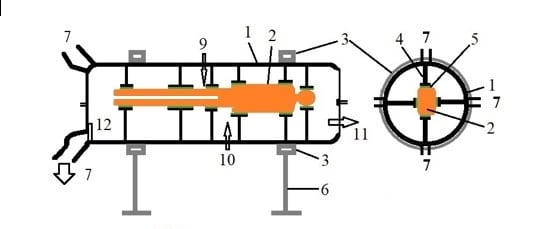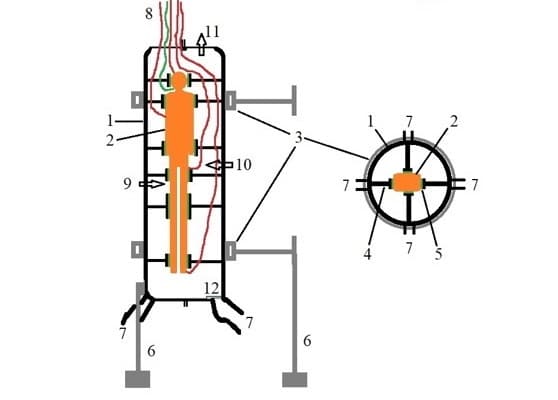Universal Rotating Intensive-Care-Bed
Goals:
- Simplify care work, avoid the physical efforts of the caregivers/nurses.
- Reduce the number of caregivers per long-term patient.
- Mechanical (automatic) change of supine position, lateral position, prone position with reduction of lung problems (ARDS) and prevention of bedsores.
- Automatically remove excretions of the long-term patient (luxury version).
- Stimulation of the limbs of the patient (movement, massage, vibration) in order to shorten his post-treatment /REHA phase and reduce the after-effects.
- Preserving the spirits of the awake patient through e-book, smartphone, TV, computer / Internet / YouTube and through simplified secure visitor contact.
Short description*:
- Rotatable hollow body (tube system), can be erected up vertically, upper part can be opened or lifted, on a stable mobile frame, in reverse position the lower part.
- The patient is transported with a special crane and lowered into the tube system, into the lower part, adjusting supports and girders. Alternatively, the patient can be placed into the pipe system with 4 to 5 strong caregivers.
- Supply and measurement systems are fed to the devices and machines on the side of the tube system or at the end of the patient’s head.
- The patient is fixed on all sides with supports and support surfaces, which are covered with elastic skin-compatible material (cushions, pillows) and are adapted to the patient’s surface.
- These supports are universal-movable and are adjusted in length.
- Large windows allow in the prone position operation of smartphone, computer, laptop and reading of e-book.
- Large windows allow, in vertical supposition, simplified food intake as well as eye contact with the visitor and, if allowed, lateral contact with the arm.
- If the top is lifted off, the patient (strapped on) can do movement exercises with his legs in vertical supposition, possibly supported.
TOILET of the luxury version:
- When the toilet is activated by the patient or by the caregiver, the patient is automatically moved into a slightly inclined supposition, with clothing and the blanket/cover being pulled upwards to the upper body.
- By patient, automatically or by nursing staff, rays are triggered with warm water, with their angles being adjusted to the patient with flexible syringes.
- The outflow of the water along the legs is prevented with rings/cuffs around the thighs of the patient.
- Due to the inclination of the tube system, the excretions are flushed downwards and leave the tube system into a container or directly into the sewerage system.
- Odor spread is prevented by simple measures.
- After the rinsing process, the patient and the environment are dried with warm air.
- Then the patient is automatically covered again. Its position can then be freely adjusted mechanically.
Quick cleaning and body care of the patient, change of clothing and blankets:
- In supposition of the patient, its front can be very quickly treated when the upper part of the tube system is opened or raised.
- Accordingly, the patient’s back can be quickly treated when the underside of the tube system is opened or raised.
Mental and physical activation of the patient:
- In supposition of the patient and after lifting the upper part of the tube system, he/she can do limited leg exercises, supported by aids and assistants.
- In the horizontal prone position and after lifting the lower part of the tube system, the patient can receive massages.
- In the luxury tube system, vibrators are attached to various supports and support plates, which can be activated by the patient or the nursing staff to reduce muscle loss by lying for a long time.
- In supposition with the vertical position of the tube system, the patient can absorb and drink food with the large window open, and with the window closed, see visitors and communicate with them. With air lift and air exhaust on the ceiling, the risk of infection is minimized.
- In a horizontal prone position and after lowering the arm supports/carrier, the patient can read e-book, operate smartphone, computer, TV and lighting and observe through the large window. Adaptation for wearers of glasses.
- The initial skepticism of the patient because of the closed tube system will mostly give way with the physical and mental activities. Also, the patient himself can open the system anytime.
Operation and automatic of the tube system
- At the foot of the tube system, a tableau is attached for the nursing staff with status display of the patient (fever, blood pressure, heart rate, breathing, oxygen content blood, etc. with fixed supply of the data from the devices at the head end) as well as with switches / buttons for the specified functions rotation and straightening of the tube system, lifting the upper part and the lower part, setting up the inclination of the tube system and activation of the toilet system, ventilation, temperature regulation of the tube system and activation of the vibrators and the entertainment devices at the head-end.
- The change from back to prone position and vice versa can be automatically or periodically adjusted computer-controlled.
- Within the tube system, there are switches on both sides of the patient, with which the patient can perform the position change, the vertical position, the toilet actions and operate the consumer electronics / volume by hand or with voice command.
- All data are permanently directed to the nursing staff’s lounge.
- With an easily accessible and visible emergency switch or microphone, the patient can request help at any time.
- Continuous emergency power supply required.
Estimated development times: 6 months for primary design with help of intensive-care specialist, 6 months for production of prototype, 3 months for testing and official safety checking.
In case of emergency these times can be reduced, by using full resources and participation of inventor, to total 4 months. The development and fabrication expenses are amortized by daily fees of bed utilization.
*Patent pending


